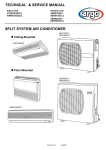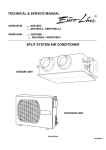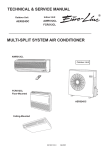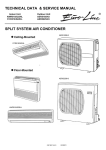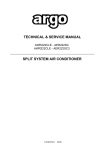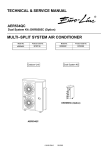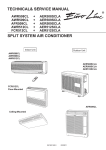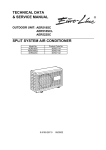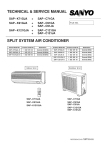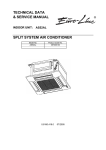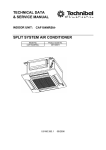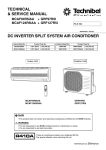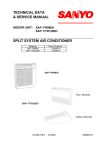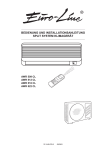Download technical data & service manual split system air conditioner
Transcript
TECHNICAL DATA & SERVICE MANUAL Indoor Unit AWR518CL FCR518CL ® Outdoor Unit AER518SC AE522SC SPLIT SYSTEM AIR CONDITIONER AER518SC FCR518CL AWR518CL 0.8180.218.0 07/2001 When Transporting Important! Please Read Before Starting Be careful when picking up and moving the indoor and outdoor units. Get a partner to help, and bend your knees when lifting to reduce strain on your back. Sharp edges or thin aluminum fins on the air conditioner can cut your fingers. This air conditioning system meets strict safety and operating standards. As the installer or service person, it is an important part of your job to install or service the system so it operates safely and efficiently. When Installing… For safe installation and trouble-free operation, you must: …In a Ceiling or Wall Make sure the ceiling/wall is strong enough to hold the units weight. It may be necessary to construct a strong wood or metal frame to provide added support. ● Carefully read this instruction booklet before beginning. ● Follow each installation or repair step exactly as shown. …In a Room Properly insulate any tubing run inside a room to prevent “sweating” that can cause dripping and water damage to walls and floors. ● Observe all local, state, and national electrical codes. ● Pay close attention to all warning and caution notices given in this manual. WARNING CAUTION …In Moist or Uneven Locations Use a raised concrete pad or concrete blocks to provide a solid, level foundation for the outdoor unit. This prevents water damage and abnormal vibration. This symbol refers to a hazard or unsafe practice which can result in severe personal injury or death. …In an Area with High Winds Securely anchor the outdoor unit down with bolts and a metal frame. Provide a suitable air baffle. This symbol refers to a hazard or unsafe practice which can result in personal injury or product or property damage. …In a Snowy Area (for Heat Pump-type Systems) Install the outdoor unit on a raised platform that is higher than drifting snow. Provide snow vents. If Necessary, Get Help When Connecting Refrigerant Tubing These instructions are all you need for most installation sites and maintenance conditions. If you require help for a special problem, contact our sales/service outlet or your certified dealer for additional instructions. • Use the flare method for connecting tubing. • Apply refrigerant lubricant to the matching surfaces of the flare and union tubes before connecting them, then tighten the nut with a torque wrench for a leakfree connection. In Case of Improper Installation The manufacturer shall in no way be responsible for improper installation or maintenance service, including failure to follow the instructions in this document. • Check carefully for leaks before starting the test run. When Servicing • Turn the power off at the main power box (mains) before opening the unit to check or repair electrical parts and wiring. Special Precautions WARNING When Wiring • Keep your fingers and clothing away from any moving parts. ELECTRICAL SHOCK CAN CAUSE SEVERE PERSONAL INJURY OR DEATH. ONLY A QUALIFIED, EXPERIENCED ELECTRICIAN SHOULD ATTEMPT TO WIRE THIS SYSTEM. • Clean up the site after you finish, remembering to check that no metal scraps or bits of wiring have been left inside the unit being serviced. Others • Do not supply power to the unit until all wiring and tubing are completed or reconnected and checked. CAUTION • Highly dangerous electrical voltages are used in this system. Carefully refer to the wiring diagram and these instructions when wiring. Improper connections and inadequate grounding can cause accidental injury or death. • Ventilate any enclosed areas when installing or testing the refrigeration system. Escaped refrigerant gas, on contact with fire or heat, can produce dangerously toxic gas. • Confirm upon completing installation that no refrigerant gas is leaking. If escaped gas comes in contact with a stove, gas water heater, electric room heater or other heat source, it can produce dangerously toxic gas. • Ground the unit following local electrical codes. • Connect all wiring tightly. Loose wiring may cause overheating at connection points and a possible fire hazard. i Table of Contents Page 1 OPERATING RANGE 2 SPECIFICATIONS 2-1 Unit Specification 2-2 Major Component Specifications 2-3 Other Component Specifications 2 4 7 3 DIMENSIONAL DATA 9 4 REFRIGERANT FLOW DIAGRAM 12 5 PERFORMANCE DATA 5-1 Performance Charts 5-2 Air Throw Distance Chart 5-3 Cooling Capacity 13 14 16 ELECTRICAL DATA 6-1 Electrical Characteristic 6-2 Electric Wiring Diagrams 18 19 INSTALLATION INSTRUCTIONS 7-1 Installation Site Selection 7-2 Remote Control Unit Installation Position 7-3 Recommended Wire Length and Diameter 21 23 24 FUNCTION 8-1 Room Temperature Control 8-2 Dry Operation 8-3 Freeze prevention 8-4 Outdoor Fan Speed Control 25 26 26 27 REFRIGERANT R407C:SPECIAL PRECAUTION WHEN SERVICING UNIT 9-1 Characteristics of new refrigerant R407c 9-2 Checklist before servicing 9-3 Tools specifically for R407c 9-4 For tubing installation procedures 9-5 In case of compressor malfunction 9-6 In case refrigerant is leaking 9-7 Charging additional refrigerant 9-8 Retro-fitting existing system 28 28 29 29 30 31 34 34 TROUBLESHOOTING 10-1 Check before and after troubleshooting 10-2 Air Conditioner Does not operate 10-3 Some Parts of Air Conditioner does not operate 10-4 Air Conditioner Operates, but abnormalities are observed 10-5 If a sensor is defective 35 36 40 42 43 6 7 8 9 10 1 ii 11 12 CHECKING ELECTRICAL COMPONENTS 11-1 Measurements of insulation resistance 11-2 Checking continuity of fuse on PCB ass’y 11-3 Checking motor capacitor 44 45 46 DISASSEMBLY PROCEDURE FOR INDOOR UNIT 12-1 Removing air intake grille 12-2 Removing side panels 12-3 Access and removal of electrical components box 12-4 Removing flap motor 12-5 Removing evaporator 12-6 Removing fan and fan motor 46 47 47 48 48 50 iii 1. OPERATING RANGE Temperature Cooling Indoor Air Intake Temp. Outdoor Air Intake Temp. Maximum 32°C D.B. / 23°C W.B. 43°C D.B. Minimum 19°C D.B. / 14°C W.B. 19°C D.B. 1 2. SPECIFICATIONS 2-1. Unit Specifications Indoor Unit Outdoor Unit AWR518CL AER518SC Power Source 230 V Single phase 50Hz Electrical Rating Performance Voltage rating V 230 Cooling Capacity kW 4.80 BTU/h 16400 m3/h Air circulation (High) Moisture removal (High) Liters/h Available voltage range V 760 2.2 198 to 264 Running amperes A 9.1 Power input W 1950 Power factor % C.O.P. 93 W/W Compressor locked rotor amperes 2.50 A 43 Controls / Temperature control Microprocessor / I.C. thermostat Control unit Wireless remote control unit Timer ON/OFF 24 hours & Daily program, 1-hour OFF Fan speeds Indoor / Outdoor 3 and Auto / Auto (Hi, Lo) Horizontal Airflow direction (Indoor) Manual Vertical Auto Features Air filter Washable Compressor Rotary (Hermetic) Refrigerant / Amount charged at shipment g R407c / 1840 Refrigerant control Noise Power Level Capillary tube Indoor – Hi / Me / Lo dB-A Outdoor – Hi dB-A 55 / 51/ 49 62 Refrigerant tubing connections Max. allowable tubing length at shipment Refrigerant tube diameter Flare type m Narrow tube mm (in.) Wide tube mm (in.) 7.5 6.35 (1/4) 12.7 (1/2) Refrigerant tube kit / Accessories Dimensions & Weight Unit dimensions Package dimensions Weight Shipping volume Height Optional / Hanging wall bracket mm Indoor Unit Outdoor Unit 285 630 Width mm 995 830 Depth mm 206 305 Height mm 276 713 Width mm 1,070 994 Depth mm 363 413 kg 12.0 52.0 Net Shipping kg 15.0 57.0 m3 0.11 0.29 DATA SUBJECT TO CHANGE WITHOUT NOTICE. Remarks: Rating conditions are: Cooling: Indoor air temperature 27°C D.B. / 19°C W.B. Outdoor air temperature 35°C D.B. / 24°C W.B. 2 Indoor Unit Outdoor Unit FCR518CL AER518SC Power Source 230 V Single phase 50Hz Electrical Rating Performance Voltage rating V 230 Cooling Capacity kW 4.80 BTU/h 16400 m3/h Air circulation (High) Moisture removal (High) Liters/h Available voltage range V 800 2.3 198 to 264 Running amperes A 9.1 Power input W 1950 Power factor C.O.P. Compressor locked rotor amperes % 93 W/W 2.5 A 43 Controls / Temperature control Microprocessor / I.C. thermostat Control unit Wireless remote control unit Timer ON/OFF 24 hours & Daily program, 1-hour OFF Fan speeds Indoor / Outdoor 3 and Auto / Auto (Hi, Lo) Horizontal Airflow direction (Indoor) Manual Vertical Auto Features Air filter Washable Compressor Rotary (Hermetic) Refrigerant / Amount charged at shipment g R407c / 1840 Refrigerant control Noise Power Level Capillary tube Indoor – Hi / Me / Lo dB-A Outdoor – Hi dB-A 58 / 55 / 52 62 Refrigerant tubing connections Max. allowable tubing length at shipment Refrigerant tube diameter Flare type m Narrow tube mm (in.) Wide tube mm (in.) 7.5 6.35 (1/4) 12.7 (1/2) Refrigerant tube kit / Accessories Dimensions & Weight Unit dimensions Package dimensions Weight Shipping volume Height Optional / Hanging wall bracket mm Indoor Unit Outdoor Unit 680 630 Width mm 900 830 Depth mm 190 305 Height mm 813 713 Width mm 1011 994 Depth mm 296 413 kg 23.5 52.0 Net Shipping kg 30.0 57.0 m3 0.24 0.29 DATA SUBJECT TO CHANGE WITHOUT NOTICE. Remarks: Rating conditions are: Cooling: Indoor air temperature 27°C D.B. / 19°C W.B. Outdoor air temperature 35°C D.B. / 24°C W.B. 3 2-2. Major Component Specifications 2-2-1. Indoor Unit Controller PCB Indoor Unit AWR518CL Part No. POW – K188E Controls Microprocessor Control circuit fuse 250 V – 3.15 A Remote Control Unit RCS – 8PS3E Type Cross-flow Q´ty ... Dia. and length mm 1 ... ø88 / L746 Fan motor model ... Q´ty UF2– 31A5PA– S ... 1 Fan & Fan Motor No. of poles ... rpm (High) 2 ... 1,305 Nominal output W 30 Coil resistance (Ambient temp. 20°C) Ω WHT – BRN : 130.4 WHT – PNK : 169.8 Safety devices Type Operating temp. –: – –: – –: – Thermal protector Open °C 130 ± 8 Close Run capacitor Automatic reclosing µF 2.0 Flap Motor 440 Stepping motor Model MP24GA2 Rating DC 12 V Heat Exch. Coil VAC Type Coil Coil resistance (Ambient temp. 20°C) Ω Each terminals (1–2, 1–3, 1–4, 1–5) 400 : ± 7% Aluminum plate fin / Copper tube Rows 2 Fin pitch mm 1.3 Face area m2 0.250 DATA SUBJECT TO CHANGE WITHOUT NOTICE. 4 Controller PCB Indoor Unit FCR518CL Part No. POW–K185GS–N Controls Microprocessor Control circuit fuse 250 V – 3 A Remote Control Unit RCS – 5PN3E Type Centrifugal Number ... Dia. and length mm 2 ... ø 130 / L 180 Fan motor model ... Number K48410–M01417 ... 1 Fan & Fan Motor No. of poles ... rpm (230 V, High) 4 ... 1,140 Nominal output W Coil resistance (Ambient temp. 20°C) Ω WHT – VLT : 87 ± 7% VLT – YEL : 87 ± 7% WHT – PNK : 273 ± 7% Safety devices Type Operating temp. Internal thermal fuse Open Flap Motor °C 145 ± 5 Close Run capacitor Automatic reclosing µF 2.0 VAC 440 Model M2LJ24ZE31 Rating AC 208 / 230 V, 50 / 60 Hz No. of poles ... rpm Nominal output Coil resistance (Ambient temp. 20°C) Heat Exch. Coil 27 GRY – WHT : 215 ± 7% 8 ... 2.5 / 3.0 W 3 / 2.5 kΩ 16.45 ± 15% Coil Aluminum plate fin / Copper tube Rows Fin pitch Face area 2 mm 1.8 m2 0.192 DATA SUBJECT TO CHANGE WITHOUT NOTICE. 5 Outdoor Unit AER518SC Controller PCB — Type Rotary (Hermetic) Compressor Compressor model C – 2RN150H5W 80805045 Nominal output W Compressor oil ... Amount cc Coil resistance (Ambient temp. 25°C) Ω 1500 DAPHNE FV68S ... 750 C – R : 1.42 C – S : 4.12 Type Safety devices Internal protector Overload relay Operating temp. — Open °C Automatic opening Close °C Automatic reclosing Operating amp.(Ambient temp. 25°C) Run capacitor — µF 40.0 VAC 450 Crank case heater Type Propeller Number ... Dia. mm 1 ... ø 400 Fan motor model ... Number Smen 19TFB6055 ... 1 Fan & Fan Motor No. of poles ... rpm (230 V, High) 6 ... 910 Nominal output W Coil resistance (Ambient temp. 20°C) Ω 43 WHT – BRN : 77.7 ± 7% WHT – YEL : 366.0 ± 7% WHT – PNK : 211.0 ± 7% Safety devices Type Operating temp. Thermal protector Open °C 130 ± 5 Close Heat Exch. Coil Run capacitor Automatic reclosing µF 5.2 VAC 440 Coil Aluminum plate fin / Copper tube Rows Fin pitch Face area 2 mm 1.8 m2 0.508 External Finish Acrylic baked-on enamel finish DATA SUBJECT TO CHANGE WITHOUT NOTICE. 6 2-3. Other Component Specifications Indoor Unit AWR518CL Transformer (TR) ATR-J105 Rating Primary AC 230V, 50 / 60 Hz Secondary 19V, 0.526A Capacity 10VA Ω (at 21°C) Coil resistance Primary (WHT – WHT): 205 ± 10% Secondary (BRN – BRN): 2.0 ± 10% Thermal cut-off temp. 150°C Thermistor (Coil sensor) Resistance DTN-TKS131B kΩ 0°C Thermistor (Room sensor) Resistance Indoor Unit 15.0 ± 2% DTN-TKS142B kΩ 25°C 5.0 ± 3% FCR518CL Thermistor (Room sensor TH2) Resistance KTEC-35-S6 kΩ 10°C 10.0 ± 4% 30°C 4.0 ± 4% 15°C 7.9 ± 4% 35°C 3.3 ± 4% 20°C 6.3 ± 4% 40°C 2.7 ± 4% 25°C 5.0 ± 4% 50°C 1.8 ± 4% Thermistor (Coil sensor TH1) Resistance PBC-41E-S14 kΩ –20°C 40.1 ± 5% –10°C 24.4 ± 5% 30°C 4.4 ± 5% 0°C 15.3 ± 5% 40°C 3.0 ± 5% 10°C Transformer (TR) Rating 9.9 ± 5% 50°C 2.1 ± 5% ATR-H85 Primary AC 230V, 50/60Hz Secondary 11V, 0.727A Capacity Coil resistance 20°C 6.5 ± 5% 8VA Ω (at 21°C) Thermal cut-off temp. Primary (WHT – WHT): 214 ± 10% Secondary (BRN – BRN): 1.58 ± 10% 145°C, 2A, 250V 7 Outdoor Unit AER518SC Power Relay G7L-2A-TUB Coil rating AC 200 – 240V, 50/60Hz Coil resistance kΩ (at 23°C) ( 21 ± 15% ) Contact rating AC 220V, 25A Thermostat (Fan Speed Control 23S) Switching temp. MQT5S-27YZJ °C Contact rating high ➞ LOW +0 23.5°C –2.5 low ➞ HIGH 27.0°C +0 –3 AC 220V, 3A 8 3. DIMENSIONAL DATA Indoor Unit AWR518CL 285 995 206 (3) 45 45 172.5 Remote control unit 147.5 147.5 Center of tubing hole (2 places) 61 18.5 Drain hose ø18 Narrow tube ø6.35 (1/4") Wide tube ø12.7 (1/2") KR188E Unit : mm 9 Indoor Unit FCR518CL 190 86 86 680 900 74 Center of tubing hole ø75 (4 places) Wide tube ø12.7 (1/2") FCR518CL 172.5 74 Narrow tube ø6.35 (1/4") Drain hose ø26 18.5 41 41 61 74 74 Dimensions : mm 10 AER518SC 538 146 337 307 Air intake 4 – ø12 holes Air discharge Wide tube service valve ø12.7 (1/2") Narrow tube service valve ø6.35 (1/4") 305 95 61 630 830 19 Outdoor Unit Unit : mm 11 4. REFRIGERANT FLOW DIAGRAM Indoor Unit AWR518CL Outdoor Unit AER518SC FCR518CL Indoor Unit Outdoor Unit Wide tube Wide tube service valve Accumulator Compressor Condenser Evaporator O.D. ø12.7 mm (1/2 ") Narrow tube Narrow tube service valve Capillary tube Strainer O.D. ø6.35 mm (1/4") Insulation of Refrigerant Tubing IMPORTANT Because capillary tubing is used in the outdoor unit, both the wide and narrow tubes of this air conditioner become cold. To prevent heat loss and wet floors due to dripping of condensation, both tubes must be well insulated with a proper insulation material. The thickness of the insulation should be a min. 8 mm. Insulation Thickness: Min. 8 mm Thickness: Min. 8 mm Narrow tube Wide tube CAUTION After a tube has been insulated, never try to bend it into a narrow curve because it can cause the tube to break or crack. 12 5. PERFORMANCE DATA 5-1. Performance charts Indoor Unit Outdoor Unit AWR518CL AER518SC ■ Cooling Characteristics Indoor inlet air D.B. temp. (°C) 16 Operating current (A) 15 14 Outdoor fan speed Low High 13 12 32 27 11 21 10 9 8 7 25 30 35 40 45 50 Low pressure at wide tube service valve MPa (kgf/cm2G) Outdoor inlet air D.B. temp. (°C) Indoor inlet air D.B. temp. (°C) 1.18 (11) 1.08 (10) 0.98 ( 9 ) Outdoor fan speed Low High 0.89 ( 8 ) 0.79 ( 7 ) 0.69 ( 6) 0.59 ( 5 ) 0.49 ( 4 ) 32 27 21 0.39 ( 3 ) 0.29 ( 2 ) 0.19 ( 1 ) 25 30 35 40 45 50 Outdoor inlet air D.B. temp. (°C) NOTE ● ...... Points of Rating condition Black dots in above charts indicate the following rating conditions. Cooling: Indoor air temperature 27°C D.B./ 19°C W.B. Outdoor air temperature 35°C D.B./24°C W.B. 13 5-2. Air Throw Distance Chart AWR518CL Room air temp. : Fan speed : 27°C High Horizontal distance (m) 0 1 2 3 4 5 6 7 0 Axis air velocity (m/s) Vertical distance (m) Indoor Unit 1 2 3 4 : Flap angle 0° , : Flap angle 30°, 14 : Axis air velocity 0° : Axis air velocity 30° 8 9 AIR FLOW CHART FCR518CL Room air temp. : Fan speed : 27°C High Floor mounted Axis air verocity (m/s) Vertical distance (m) 4 3 2 Axis air verocity 1 Flap angle 60° 0 45° 0 1 2 3 4 5 6 7 Horizontal distance (m) Ceiling mounted 0 Axis air verocity (m/s) Vertical distance (m) Indoor Unit 0 1 2 3 Horizontal distance (m) 4 5 6 7 Axis air verocity 1 Flap angle 2 30° 3 45° 4 15 5-3. Cooling Capacity Indoor Unit AWR518CL Outdoor Unit AER518SC RATING CAPACITY AIR FLOW RATE EVAPORATOR ENT.TEMP. °C W.B. D.B. 15 17 19 21 23 TC: 21 23 25 27 29 31 21 23 25 27 29 31 21 23 25 27 29 31 23 25 27 29 31 25 27 29 31 4.8 kW 760 m³/h TC CM SHC SHC SHC SHC SHC SHC TC CM SHC SHC SHC SHC SHC SHC TC CM SHC SHC SHC SHC SHC SHC TC CM SHC SHC SHC SHC SHC TC CM SHC SHC SHC SHC CONDENSER OUTDOOR AMBIENT TEMP. 25 30 35 4.55 4.41 4.21 1.61 1.71 1.84 3.12 3.06 2.95 3.54 3.46 3.36 3.94 3.86 3.76 4.35 4.27 4.16 4.55 4.41 4.21 4.55 4.41 4.21 4.93 4.74 4.51 1.64 1.76 1.89 2.73 2.65 2.55 3.14 3.05 2.94 3.55 3.45 3.35 3.96 3.85 3.75 4.38 4.26 4.15 4.79 4.65 4.51 5.22 5.04 4.80 1.72 1.82 1.95 2.29 2.21 2.11 2.69 2.62 2.51 3.08 3.02 2.91 3.47 3.42 3.32 3.86 3.82 3.71 4.27 4.23 4.12 5.53 5.34 5.09 1.76 1.87 2.01 2.26 2.18 2.08 2.64 2.58 2.48 3.04 2.98 2.88 3.43 3.38 3.29 3.83 3.79 3.68 5.91 5.66 5.34 1.80 1.91 2.06 2.21 2.12 2.00 2.59 2.51 2.40 2.98 2.92 2.81 3.41 3.33 3.20 TOTAL COOLING CAPACITY °C 40 3.94 2.02 2.83 3.23 3.63 3.94 3.94 3.94 4.24 2.08 2.42 2.82 3.22 3.62 4.03 4.24 4.51 2.14 1.98 2.39 2.80 3.19 3.60 4.00 4.78 2.20 1.95 2.36 2.77 3.16 3.57 5.00 2.25 1.88 2.27 2.68 3.08 kW SHC: SENSIBLE HEAT CAPACITY kW CM: COMPRESSOR INPUT kW RATING CONDITIONS OUTDOOR AMBIENT TEMPERATURE 35°C D.B. INDOOR UNIT ENTERING AIR TEMP. 27°C D.B./19°C W.B. 16 43 3.64 2.20 2.68 3.09 3.49 3.64 3.64 3.64 3.90 2.26 2.26 2.67 3.07 3.47 3.87 3.90 4.15 2.32 1.84 2.24 2.64 3.05 3.44 3.85 4.40 2.39 1.81 2.21 2.61 3.02 3.42 4.65 2.45 1.75 2.15 2.56 2.96 Indoor Unit FCR518CL Outdoor Unit AER518SC RATING CAPACITY AIR FLOW RATE EVAPORATOR ENT.TEMP. °C W.B. D.B. 15 17 19 21 23 21 23 25 27 29 31 21 23 25 27 29 31 21 23 25 27 29 31 23 25 27 29 31 25 27 29 31 4.8 kW 760 m³/h TC CM SHC SHC SHC SHC SHC SHC TC CM SHC SHC SHC SHC SHC SHC TC CM SHC SHC SHC SHC SHC SHC TC CM SHC SHC SHC SHC SHC TC CM SHC SHC SHC SHC CONDENSER OUTDOOR AMBIENT TEMP. 25 30 35 4.55 4.41 4.21 1.61 1.71 1.84 3.12 3.06 2.95 3.54 3.46 3.36 3.94 3.86 3.76 4.35 4.27 4.16 4.55 4.41 4.21 4.55 4.41 4.21 4.93 4.74 4.51 1.64 1.76 1.89 2.73 2.65 2.55 3.14 3.05 2.94 3.55 3.45 3.35 3.96 3.85 3.75 4.38 4.26 4.15 4.79 4.65 4.51 5.22 5.04 4.80 1.72 1.82 1.95 2.29 2.21 2.11 2.69 2.62 2.51 3.08 3.02 2.91 3.47 3.42 3.32 3.86 3.82 3.71 4.27 4.23 4.12 5.53 5.34 5.09 1.76 1.87 2.01 2.26 2.18 2.08 2.64 2.58 2.48 3.04 2.98 2.88 3.43 3.38 3.29 3.83 3.79 3.68 5.91 5.66 5.34 1.80 1.91 2.06 2.21 2.12 2.00 2.59 2.51 2.40 2.98 2.92 2.81 3.41 3.33 3.20 TC: TOTAL COOLING CAPACITY kW SHC: SENSIBLE HEAT CAPACITY kW CM: COMPRESSOR INPUT kW °C 40 3.94 2.02 2.83 3.23 3.63 3.94 3.94 3.94 4.24 2.08 2.42 2.82 3.22 3.62 4.03 4.24 4.51 2.14 1.98 2.39 2.80 3.19 3.60 4.00 4.78 2.20 1.95 2.36 2.77 3.16 3.57 5.00 2.25 1.88 2.27 2.68 3.08 RATING CONDITIONS OUTDOOR AMBIENT TEMPERATURE 35°C D.B. INDOOR UNIT ENTERING AIR TEMP. 27°C D.B./19°C W.B. 17 43 3.64 2.20 2.68 3.09 3.49 3.64 3.64 3.64 3.90 2.26 2.26 2.67 3.07 3.47 3.87 3.90 4.15 2.32 1.84 2.24 2.64 3.05 3.44 3.85 4.40 2.39 1.81 2.21 2.61 3.02 3.42 4.65 2.45 1.75 2.15 2.56 2.96 6. ELECTRICAL DATA 6-1. Electrical Characteristics Indoor Unit Outdoor Unit AWR518CL AER518SC Indoor Unit Outdoor Unit Fan Motor Fan Motor Performance at Complete Unit Compressor 230V Single phase 50Hz Rating Conditions Running Amps. Power Input Full Load Conditions Running Amps. Power Input A kW A kW 0.37 0.50 8.23 9.1 0.070 0.093 1.78 1.95 0.37 0.50 9.63 10.5 0.070 0.093 2.13 2.30 Rating Conditions : Indoor Air Temperature 27°C D.B. / 19°C W.B. Outdoor Air Temperature 35°C D.B. Full Load Conditions : Indoor Air Temperature 32°C D.B. / 23°C W.B. Outdoor Air Temperature 46° C D.B. Indoor Unit FCR518CL Outdoor Unit AER518SC Indoor Unit Outdoor Unit Fan Motor Fan Motor Performance at Rating Conditions Complete Unit Compressor 230V Single phase 50Hz Running Amps. Power Input Full Load Conditions Running Amps. Power Input A kW A kW 0.33 0.50 8.27 9.1 0.070 0.093 1.78 1.95 0.33 0.50 9.67 10.5 0.070 0.093 2.13 2.30 Rating Conditions : Indoor Air Temperature 27°C D.B. / 19°C W.B. Outdoor Air Temperature 35°C D.B. Full Load Conditions : Indoor Air Temperature 32°C D.B. / 23°C W.B. Outdoor Air Temperature 46°C D.B. 18 6-2 Electric Wiring Diagrams Indoor Unit AER518CL Outdoor Unit AER518SC WARNING 19 To avoid electrical shock hazard, be sure to disconnect power before checking, servicing and/or cleaning any electrical parts Indoor Unit FCR518CL WARNING 20 To avoid electrical shock hazard, be sure to disconnect power before checking, servicing and/or cleaning any electrical parts , 7. INSTALLATION INSTRUCTIONS 7-1. Installation Site Selection Indoor Unit WARNING To prevent abnormal heat generation and the possibility of fire, don’t place obstacles, enclosures and grills in front of or surrounding the air conditioner in a way that may block air flow. AVOID: ● direct sunlight. 15 cm min. INDOOR UNIT Front View Fig.1 ● nearby heat sources that may affect performance of the unit. INDOOR UNIT ● areas where leakage of flammable gas may be expected. ● places where large amounts of oil mist exist. DO: 15 cm min. 15 cm min. Tubing length (L) Elevation difference (H) ● select an appropriate position from which every corner of the room can be uniformly air-conditioned. (High on a wall is best) OUTDOOR UNIT Fig. Fig.2a 2 ● select a location that will hold the weight of the unit. ● select a location where tubing and drain pipe have the shortest run to the outside. CAUTION For stable operation of the air conditioner, do not install wall-mounted type indoor units less than 1.5m from floor level. ● allow room for operation and maintenance as well as unrestricted air flow around the unit. (Fig. 1) ● install the unit within the maximum elevation difference (H) above or below the outdoor unit and within a total tubing length (L) from the outdoor unit as detailed Table 1 and Fig. 2a. Indoor Unit Wall Minimum height from floor level 1.5m Floor level Fig. 2b Table 1 Model AER518SC Max. Allowable Tubing Length at Shipment (m) Limit of Tubing Length (L) (m) Limit of Elevation Difference (H) (m) Required Amount of Additional Refrigerant (g / m)* 7.5 20 7 25 * If total tubing length becomes 7.5 to 20 m (max.), charge additional refrigerant ( R407c) by 25 g / m. No additional charge of compressor oil is necessary. 21 Outdoor Unit AVOID: ● heat sources, exhaust fans, etc. (Fig. 3) ● damp, humid or uneven locations. Exhaust fan Hot air Heat source DO: ● choose a place as cool as possible. Outdoor unit ● choose a place that is well ventilated. ● allow enough room around the unit for air intake/exhaust and possible maintenance. (Figs. 4a to 4b Fig. 3 Fig. 3 ● provide a solid base (concrete block, 10 ✕ 40 cm beams or equal), a minimum of 10 cm above ground level to reduce humidity and protect the unit against possible water damage and decreased service life. (Fig.5a) ● use lug bolts or equal to bolt down unit, reducing vibration and noise. Required space around the unit. AER518SC mod. AER518SC mod. Obstacle above Valve side Min. 25 cm Min. 40 cm Air discharge Min. 2m Min. 2m Obstacle Min. 5 cm Min. 10 cm Air discharge Air intake Top View Top View Fig. 4a Ground Side View Fig. 4c Fig 4 C AER518SC mod. Anchor bolts (4 pcs.) Min. 10 cm Air intake Concrete or equal Ab t 10 ou t4 Abou cm 0c m Fig. 5 - B Fig. 5a Fig. 5 - A 22 7-2. Remote Control Unit Installation Position Removable mounting Wall The remote control unit can be operated from either a non-fixed position or a wall-mounted position. To ensure that the air conditioner operates correctly, do not install the remote control unit in the following places: Special mounting screw ● In direct sunlight ● Behind a curtain or other place where it is covered ● More than 8 m away from the air conditioner ● In the path of the air conditioner's airstream Fig.6a ● Where it may become extremely hot or cold ● Where it may be subject to electrical or magnetic interference Mounting on a Wall Non-removable mounting a) Removable mounting Wall 1) Momentarily hold the remote control unit at the desired mounting position. 2) Confirm that the air conditioner responds correctly when you press keys on the remote control from that position. 3) After confirming correct operation, use a screwdriver to screw the supplied special mounting screw into the wall. (Fig.6a) 4) Hang the remote control unit from the mounting screw. Screw Fig.6b b) Non-removable mounting 1) Momentarily hold the remote control unit at the desired mounting position. 2) Confirm that the air conditioner responds correctly when you press keys on the remote control from that position. 3) After confirming correct operation, use a screwdriver to screw the supplied special mounting screw into the wall. (Fig.6a) 4) Remove the remote control cover by sliding it downward. 5) Remove the batteries of the remote control unit. 6) Use a screwdriver to screw the remote control unit securing screw into the wall through the hole in the battery compartment. (Fig.6b) 7) Replace the batteries. 8) Again confirm that the remote control unit operates correctly. 23 7-3. Recommended Wire Length and Size Regulations on wiring diameter differ from locality to locality. For field wiring requirements, please refer to your local electrical codes. Carefully observe these regulations when carrying out the installation. NOTE Refer to the WIRING SYSTEM DIAGRAM for the meaning of "A" and "B" in Table 2. Table 2 lists recommended wire lengths and cross section area for power supply systems. Table 2 Cross-Sectional Area (mm2) Model (B) Power Line (A) Power Supply Wiring Length (m) 2.5 mm 2 2.5 mm 2 AER518SC WARNING 20 22 ● Be sure to comply with local codes on running the wire from the indoor unit to the outdoor unit (size of wire and wiring method, etc.). INDOOR UNIT 1 2 ● No wire should be allowed to touch refrigerant tubing, the compressor, or any moving part. CAUTION 20 A WIRING SYSTEM DIAGRAM ● Each wire must be firmly connected. WARNING Fuse or Circuit Breaker Capacity AER518SC OUTDOOR UNIT (B) 1 2 4 To avoid the risk of electric shock, each air conditioner unit must be grounded. 4 L N Ground Power supply 220 – 240 V 50Hz ● Be sure to connect the power supply line to the outdoor unit as shown in the wiring diagram. The indoor unit draws its power from the outdoor unit. 24 (A) 8. FUNCTION 8-1. Room Temperature Control ● Room temperature control is obtained by cycling the compressor ON and OFF under control of the room temperature sensor in the remote control unit. ● The room temperature (and other information) is transmitted every 3 minutes by the remote control unit to the controller in the indoor unit. Signal from remote control unit 3 minutes 3 minutes 3 minutes Thermo. OFF set temp. 3 minutes Thermo. ON Thermo. OFF 3 minutes 3 minutes 3 minutes Thermo. ON Thermo. ON Thermo. ON Thermo. OFF T+1 °C T °C More than 5 minutes 5 minutes 3 minutes Room temp. Compressor ON OFF ON OFF ON OFF Outdoor fan ON OFF ON OFF ON OFF Indoor fan Set speed ● The control circuit will not attempt to turn the compressor ON until the compressor has been OFF for at least 3 minutes. To protect the compressor from stalling out when trying to start against the high side refrigerant pressure, the control circuit has a built-in automatic time delay to allow the internal pressure to equalize. ● As a protective measure, the control circuit switches the compressor OFF after 5 minutes or more of compressor operation. ● Thermo. ON : When the room temperature is above T + 1°C (T°C is set temperature). Compressor ➞ ON ● Thermo. OFF : When the room temperature is equal to or below set temperature T°C. Compressor ➞ OFF 25 8-2. Dry Operation (Dehumidification) ● Dry operation uses the ability of the cooling cycle to remove moisture from the air, but by running at low level to dehumidify without greatly reducing the room temperature. The air conditioner repeats the cycle of turning ON and OFF automatically as shown in the chart below according to the room temperature. Room temp. Cooling operation T+2 °C Set temp. T °C T–1 °C ✻Dry A zone Compressor : Continuous operation FMI (indoor fan) : L (low speed) / LL (very low speed) intermittent ventilation only while the compressor is ON. ✻Dry B zone Compressor : Intermittent operation (ON for 3 minutes and OFF for 9 minutes) FMI (indoor fan) : L (low speed) / LL (very low speed) intermittent ventilation only while the compressor is ON. Room temp. 15 °C Monitor zone Both the indoor and outdoor units stop. NOTE ● Intermittent ventilation occurs by switching the indoor fan speed between L ↔ LL. ● Dry operation does not occur when the room temperature is under 15°C, which is the monitor zone. ● When the compressor stops, the indoor fan stops as well. 8-3. Freeze Prevention ● This function prevents freezing of the indoor heat exchange coil. ● When the compressor has been running for 10 minutes or more and the temperature of the indoor heat exchange coil falls below –1°C, the control circuit stops the compressor for at least 6 minutes. The compressor does not start again until the temperature rises above 8°C or 6 minutes has elapsed. Thermo. OFF Thermo. ON Room temp. T+1 ° C Set temp. T ° C Indoor heat exch. coil temp. More than 6 minutes 6 minutes –1 ° C More than 10 minutes Compressor Indoor fan ON More than 10 minutes OFF ON ON Set speed OFF Set speed 26 ON 8-4. Outdoor Fan Speed Control ● To optimize performance of the air conditioner, the outdoor fan speed is switched automatically according to the outdoor temperature. ● If the outdoor air temperature falls below A°C, the fan speed switches to LOW. ● If the outdoor air temperature rises above B°C, the fan speed switches to HIGH. B Outdoor air temperature (°C) A Outdoor fan speed NOTE H H L The operating temperature shown as A and B in the chart differ by models. Models AER518SC 27 A B 23.5°C 27.0°C 9. REFRIGERANT R407C : SPECIAL PRECAUTIONS WHEN SERVICING UNIT 9-1. Characteristics of new refrigerant R407C 9-1-1. What is new refrigerant R407C R407C is a new refrigerant that contains three types of non-azeotropy-type mixed refrigerant which does not adversely affect the Earth's ozone layer. Its refrigeration capacity and energy efficiency are about the same level as the conventional refrigerant R22 9-1-2. Components (mixing proportions) HFC32 (23%) / HFC125 (25%) / HFC134a (52%) 9-1-3. Characteristics ● Less toxic, more chemically stable refrigerant. ● Composition of refrigerant R407C changes whether it is in gaseous phase or liquid phase. Thus, when there is a refrigerant leak the basic performance of the air conditioner may be degraded because of a change in composition of the remaining refrigerant. Therefore, do not add new refrigerant. Instead, recover the remaining refrigerant with the refrigerant recovery unit. Then, after evacuation, totally recharge the specified amount of refrigerant with the new refrigerant at its normal mixed composition state (liquid phase). ● When refrigerant R407C is used, the composition will differ depending on whether it is in gaseous or liquid phase, and the basic performance of the air conditioner will be degraded if it is charged while the refrigerant is in gaseous state. Thus, always charge the refrigerant while it is in the liquid phase. CAUTION ● Ether-type oil is used for the compressor oil for R407C-type units, which is different from the mineral oil used for R22. Thus more attention to moisture prevention and faster replacement work compared with conventional models are required. 9-2. Checklist before servicing ● Tubing precautions Refrigerant R407C is more easily affected by dust or moisture compared with R22, thus be sure to temporarily cover the ends of the tubing with caps or tape prior to installation. ● No addition of compressor oil for R407C No additional charge of compressor oil is permitted. ● No use of refrigerant other than R407C Never use a refrigerant other than R407C. ● If refrigerant R407C is exposed to fire Through welding, etc., toxic gas may be released when R407C refrigerant is exposed to fire. Therefore, be sure to provide ample ventilation during installation work. ● Caution in case of R407C leak Check for possible leak points with the special leak detector for R407C. If a leak occurs inside the room, immediately provide thorough ventilation. 28 9-3. Tools specifically for R407C ● For servicing, use the following tools for R407C Tool Distinction Tool Name • Gauge manifold • Charging hose • Gas leak detector • Refrigerant cylinder • Charging cylinder Tools specifically for R407C • Refrigerant recovery unit • Vacuum pump with anti-reverse flow (✽1) (Solenoid valve-installed type, which prevents oil from flowing back into the unit when the power is off, is recommended.) • Vacuum pump (✽2) ..... can be used if the following adapter is attached. • Vacuum pump adapter (reverse-flow prevention adapter) (✽3). (Solenoid valve-installed adapter attached to a conventional vacuum pump.) • Electronic scale for charging refrigerant • Flare tool • Bender Tools which can be commonly • Torque wrench used for R22 and R407C • Cutter, Reamer • Welding machine, nitrogen gas cylinder CAUTION ● The above tools specifically for R407C must not be used for R22. Doing so will cause malfunction of the unit. ● For the above vacuum pump (✽1, ✽2) and vacuum pump adapter (✽3) , those for R22-type units can be used for R407C-type. However, they must be used exclusively for R407C and never alternately with R22. 9-4. For tubing installation procedures ● When the tubes are connected, always apply HAB oil on the flare portions to improve the sealing of tubing. The following is the HAB oil generally used: Esso: ZERICE S32 NOTE For details on tubing installation procedures, refer to the installation manuals attached to the indoor unit and outdoor unit. 29 9-5. In case of compressor malfunction CAUTION ● Should the compressor malfunction, be sure to replace compressor as quickly as possible. ● Use only the tools indicated exclusively for R407C. ➞ See "9-3. Tools specifically for R407C". 9-5-1.Procedure for replacing compressor (1) Recovering refrigerant • Any remaining refrigerant inside the unit should not be released to the atmosphere, but recovered using the refrigerant recovery unit for R407C. (1). Recovering refrigerant OK • Do not reuse the recovered refrigerant, since will contain impurities. (2) Replacing compressor (2). Replacing compressor • Soon after removing pinched pipes of both discharge and suction tubes of the new compressor, replace it quickly. OK (3) Checking for sealing (3). Checking for sealing • Use nitrogen gas for the pressurized gas, and never use a refrigerant other than R407C. Also do not use oxygen or any flammable gas. OK (4) Evacuation • Use a solenoid valve-installed vacuum pump so that even if power is cut off in the middle of evacuation of air due to a power interruption, the valve will prevent the pump oil from flowing back. • The equipment may be damaged if moisture remains in the tubing, thus carry out the evacuation thoroughly. • When using a vacuum pump with exhaust air volume more than 25L/min. and ultimate vacuum pressure rate of 0.05Torr: Standard time of evacuation Length of tubing Time Less than 10 m More than 10 m More than 10 min. More than 15 min. 30 (4). Evacuation OK (5). Recharging (5) Recharging Valve • Be sure to charge the specified amount of refrigerant in liquid state using the service port of wide tube service valve. The proper amount is listed on the unit's nameplate. When the entire amount cannot be charged all at once, charge gradually while operating the unit in Cooling Operation. CAUTION Liquid ● Never charge a large amount of liquid refrigerant at once to the unit. This may cause damage to the compressor. • When charged with a refrigerant cylinder, use the electronic scale for charging refrigerant. In this case, if the volume of refrigerant in the cylinder becomes less than 20% of the fully-charged amount, the composition of the refrigerant starts to change. Thus, do not use the refrigerant if the amount in the refrigerant cylinder is less than 20%. Single valve Charge the liquid refrigerant with the cylinder in the up-side-down position. Fig. 1 Valve Also, charge the minimum necessary amount to the cylinder before using it for charging the air conditioning unit. Example: In case of charging refrigerant to a unit requiring 0.76Kg using a capacity of 10Kg-cylinder, the minimum necessary amount for the cylinder is: 0.76 + 10 x 0.20 = 2.76Kg Liquid Single valve (with siphon tube) Charge with the cylinder in the normal position. For the remaining refrigerant, refer to the instructions of the refrigerant manufacturer. Configurations and characteristics of cylinders • If using a charging cylinder, transfer the specified amount of liquid refrigerant from the refrigerant cylinder to the charging cylinder. Prepare an evacuated charging cylinder beforehand. CAUTION Fig. 2 NO! ● To prevent the composition of R407C from changing, never bleed the refrigerant gas into the atmosphere while transferring the refrigerant. (Fig. 3) Charging cylinder Do not use the refrigerant if the amount in the charging cylinder is less than 20%. Liquid Open Refrigerant cylinder Fig.3 31 9-6. In case refrigerant is leaking CAUTION ● Never attempt to charge additional refrigerant when refrigerant has been leaking from the unit. Follow the procedure described below to locate points of leaks and carry out repairs, then recharge the refrigerant. (1) Detecting Leaks • Use the detector for R407C to locate refrigerant leak points. (2) Recovering refrigerant (1). Detecting leaks • Never release the gas to the atmosphere, recover residual refrigerant using the refrigerant recovery unit for R407C, instead. OK • Do not reuse the recovered refrigerant because its composition will have been altered. (2). Recovering refrigerant (3) Welding leaking points OK • Confirm again that no residual refrigerant exists in the unit before starting welding. • Weld securely using flux and wax for R407C. • Prevent oxide film from forming inside the tubes utilizing substitution with nitrogen (N2) in the refrigerant circuit of the unit. Leave ends of tubes open during welding. (4) Checking for sealing (3). Welding leaking points OK (4). Checking for sealing • Use nitrogen gas for the pressurized gas, and never use a refrigerant other than R407C. Also do not use oxygen or any flammable gas. OK (5) Evacuation (5). Evacuation • Use a solenoid valve-installed vacuum pump so that even if power is cut off in the middle of evacuation of air due to a power interruption, the valve will prevent the pump oil from flowing back. • The equipment may be damaged if moisture remains in the tubing, thus carry out the evacuation thoroughly. • When using a vacuum pump with exhaust air volume more than 25L/min. and ultimate vacuum pressure rate of 0.05Torr: Standard time of evacuation Length of tubing Time Less than 10 m More than 10 m More than 10 min. More than 15 min. 32 OK (6). Recharging (6) Recharging Valve • Be sure to charge the specified amount of refrigerant in liquid state using the service port of wide tube service valve. The proper amount is listed on the unit's nameplate. When the entire amount cannot be charged all at once, charge gradually while operating the unit in Cooling Operation. CAUTION ● Never charge a large amount of liquid refrigerant at once to the unit. This may cause damage to the compressor. • When charged with a refrigerant cylinder, use the electronic scale for charging refrigerant. In this case, if the volume of refrigerant in the cylinder becomes less than 20% of the fully-charged amount, the composition of the refrigerant starts to change. Thus, do not use the refrigerant if the amount in the refrigerant cylinder is less than 20%. Liquid Single valve Charge the liquid refrigerant with the cylinder in the up-side-down position. Fig. 4 Valve Also, charge the minimum necessary amount to the cylinder before using it for charging the air conditioning unit. Example: In case of charging refrigerant to a unit requiring 0.76Kg using a capacity of 10Kg-cylinder, the minimum necessary amount for the cylinder is: 0.76 + 10 x 0.20 = 2.76Kg Liquid Single valve (with siphon tube) Charge with the cylinder in the normal position. For the remaining refrigerant, refer to the instructions of the refrigerant manufacturer. Configurations and characteristics of cylinders • If using a charging cylinder, transfer the specified amount of liquid refrigerant from the refrigerant cylinder to the charging cylinder. NO! Prepare an evacuated charging cylinder beforehand. CAUTION Fig. 5 ● To prevent the composition of R407C from changing, never bleed the refrigerant gas into the atmosphere while transferring the refrigerant. (Fig. 6) Charging cylinder Liquid Do not use the refrigerant if the amount in the charging cylinder is less than 20%. Open Refrigerant cylinder Fig. 6 33 9-7. Charging additional refrigerant 9-7-1.When tubes are extended • Observe the proper amount of refrigerant as stated in this service manual or the installation manual that came with the indoor unit. Charge additional refrigerant in liquid state. CAUTION ● Never charge additional refrigerant if refrigerant is leaking from the unit. Follow instructions given in "9-6. In case refrigerant is leaking" and completely carry out repairs. Only then should you recharge the refrigerant. 9-8. Retro-fitting existing systems 9-8-1 Use of existing units • Never use new refrigerant R407C for existing units which use R22. This will cause the air conditioner to operate improperly and may result in a hazardous condition. 9-8-2 Use of existing tubing • If replacing an older unit that used refrigerant R22 with a R407C unit, do not use its existing tubing. Instead, completely new tubing must be used. 34 10. TROUBLESHOOTING 10-1. Check before and after troubleshooting WARNING Hazardous voltage can cause ELECTRIC SHOCK or DEATH. Disconnect power or turn off circuit breaker before you start checking or servicing. 10-1-1. Check power supply wiring. ● Check that power supply wires are correctly connected to terminals L and N on the terminal plate in the outdoor unit. Indoor unit 1 2 Outdoor unit Ground 4 1 2 4 L N Inter–unit power wiring Power supply : 220–240V~50Hz Ground 10-1-2. Check inter-unit wiring. ● Check that inter-unit wiring is correctly connected to the indoor unit from the outdoor unit. 10-1-3. Check power supply. ● Check that voltage is in specified range (±10% of the rating). ● Check that power is being supplied. 10-1-4. Check lead wires and connectors in indoor and outdoor units. ● Check that coating of lead wires is not damaged. ● Check that lead wires and connectors are firmly connected. ● Check that wiring is correct. 35 10-2. Air conditioner does not operate. 10-2-1. Circuit breaker trips (or fuse blows). A. When the circuit breaker is set to ON, it is tripped soon. (Resetting is not possible.) ● There is a possibility of ground fault. ● Check insulation resistance. If resistance value is 2MΩ or less, insulation is defective (“NO”). 2 Indoor unit 1 Inter–unit wiring 1 2 1 Outdoor unit 1 2 3 4 4 AER518SC Power supply wiring L Circuit breaker N Power supply Ground WARNING * Set circuit breaker to OFF. 1 Remove both power supply wires and inter-unit wires from terminal plate in outdoor unit. • Measure insulation resistance of outdoor unit. NO Insulation of outdoor unit is defective. • Measure insulation resistance of electrical parts in outdoor unit. 2 Remove inter-unit wires from terminal plate in indoor unit. • Measure insulation resistance of indoor unit. NO Insulation of indoor unit is defective. • Measure insulation resistance of electrical parts in indoor unit. B. Circuit breaker trips in several minutes after turning the air conditioner on. ● There is a possibility of short circuit. • Check capacity of circuit breaker. Replace with suitable one (larger capacity). NO Capacity of circuit breaker is suitable. Measure resistance of outdoor fan • motor winding. • Measure resistance of compressor motor winding. 36 10-2-2. Neither indoor nor outdoor unit runs. A. Power is not supplied. • Check power supply. Circuit breaker is tripped. Reset breaker. Power failure Wait for recovery or contact power company. NO Power is being supplied to the outdoor unit. B. Check remote control unit. • Try to run with another remote control unit. OK First remote control unit is defective. • Check for residue buildup on transmitter of remote control unit. Clean transmitter. • Check for residue buildup on remote control receiver on front of indoor unit. Clean receiver. C. Check "OPERATION selector" switch in the indoor unit. • OPERATION selector switch is set in ON position. YES Indoor PCB Ass'y is defective. NO Set OPERATION selector switch to ON. D. Check transformer in indoor unit. • Measure resistance of primary and secondary winding. (TR) 37 E. Check fuse on the indoor PCB Ass'y. • Check fuse on indoor PCB Ass'y for continuity. (F) If fuse has been blown, • Measure resistance of indoor fan motor winding. (FM) OK OK • Measure resistance of flap motor winding. (FLP) • Check operation lamp to see if light is ON. Light is OFF OK • Measure resistance of primary and secondary winding of transformer. (TR) • Measure coil resistance of either power relay or magnetic contactor. (PR or MG ) OK OK Indoor PCB Ass'y or switch Ass'y is defective. Replace the fuse. F. Check TIMER on the remote control unit. • Timer is turned ON. Check to see if ON is displayed on remote control. YES Cancel the timer mode. 38 10-2-3. Only outdoor unit does not run. A. Check setting temperature. Is room temperature too low ? NO Try to lower setting temperature by temperature setting button ( button). Outdoor unit still does not run. • Try to run using another remote control unit. OK Remote control unit is defective. B. Check power relay in outdoor unit. • Power relay sounds "click" when 220 to 240V is applied. (PR) OK Check indoor PCB Ass'y. 39 10-3. Some part of air conditioner does not operate. 10-3-1. Only indoor fan does not run. • Check fan rotation. Turn fan gently once or twice by hand. • Check fan casing foreign matter on inside. Fan cannot be turned. Fan motor burnout or foreign matter in bearings. Remove foreign matter or repair. Repair or replace. • Measure resistance of indoor fan motor winding. OK • Check fan motor capacitor. (C1) 10-3-2. Only outdoor fan does not run. • Check fan rotation. Turn fan gently once or twice by hand. • Check fan casing foreign matter on inside. Fan cannot be turned. Fan motor burnout or foreign matter in bearings. • Measure resistance of outdoor fan motor winding. OK • Check fan motor capacitor. (C2) 40 Remove foreign matter or repair. Repair or replace. 10-3-3. Only compressor does not run. • Check compressor motor capacitor. (C3) • Either internal protector or overload relay is working. (Either OLR or 49C) YES • Measure resistance of compressor motor winding. • Temperature of compressor is abnormally high. YES YES Refrigerant gas shortage. Charge refrigerant gas(R407c). NO Rotor may be locked up. 10-3-4. Only flap motor does not run. • Measure resistance of flap (FLP) motor winding. 10-3-5. Function of outdoor fan speed control does not work properly. • Check thermostat in outdoor unit. (23S) Refer to "8-4. Outdoor Fan Speed Control". 41 10-4. Air conditioner operates, but abnormalities are observed. 10-4-1. Poor cooling. • Check position of remote control unit. • Cool air from air conditioner reaches position directly. YES Change position of remote control unit. • Wide and narrow tubes between indoor unit and outdoor unit are insulated. NO Insulate both wide and narrow tubes separately and then tape together. YES • Measure temperature of suction and discharge air of air conditioner. Temperature difference is small. Possibility of gas shortage. Charge refrigerant gas (R 407c). Temperature difference between suction and discharge air is large enough (approx. 10 deg. or more). Check for clogging of air filter. Clean filter. Air filter is clogged. • Fan speed is set to LOW. YES Set fan speed to either HIGH or MEDIUM. Reduce cooling load or replace the air conditioner with larger capacity. • Review cooling load estimate, if performance of air conditioner is normal. 10-4-2. Excessive cooling. • Set temperature is suitable. • Remote control unit is placed where it can detect room temperature properly. Set temperature to higher value using temperature setting buttons of the remote control unit. NO NO Change position of remote control unit. 42 10-5. If a sensor is defective. 10-5-1. Indoor coil temp. thermistor (TH1) is defective. A. Open When thermistor opens, the air conditioner will be in the following conditions as the controller tries to detect extremely low indoor coil temperature. In Cooling mode: Function of freeze prevention continues to work. That is, the controller turns both compressor and outdoor fan motor periodically ON and OFF for several minutes. (Refer to "8-3. Freeze Prevention") B. Short When thermistor is short, the air conditioner will be in the following conditions as the controller tries to detect extremely high indoor coil temperature. In Cooling mode: Function of freeze prevention will not work even when the frost builds up on indoor heat exchanger coil 10-5-2. Room temp. thermistor (TH2) is defective. A. Open When thermistor opens, the air conditioner will be in the following conditions as the controller tries to detect extremely low room temperature. In Cooling mode: The air conditioner soon stops and will not start again. (Thermo.OFF) Neither outdoor fan nor compressor runs. B. Short When thermistor is short, the air conditioner will be in the following conditions as Temperature the controller tries to detect extremely high room temperature. sensor In Cooling mode: The air conditioner continues to operate (Thermo.ON). Both the outdoor fan and compressor do not stop. As a result, the Lead room becomes too cold. wires NOTE Definition of Open or Short Circuit of Sensor (Thermistor) Thermistor Structure Open ... A lead wire is broken or disconnected or the circuit inside the temperature sensor is open . Short ... The protective cover of a lead wire has been damaged, and the exposed wire is touching another metal part, or both lead wires have become exposed and are touching each other. Alternatively, the circuit inside the temperature sensor is closed. 43 11. CHECKING ELECTRICAL COMPONENTS 11-1. Measurement of Insulation Resistance Ground wire Clip ● The insulation is in good condition if the resistance exceeds 2MΩ. Probe 11-1-1. Power Supply Wires Insulation tester Clamp the ground wire of the power supply wires with the lead clip of the insulation resistance tester and measure the resistance by placing a probe on either of the power wires. (Fig. 1) Fig. 1 Terminal plate Then measure the resistance between the ground wire and the other power wire. (Fig. 1) Probe 11-1-2. Indoor Unit Clamp an aluminum plate fin or copper tube with the lead clip of the insulation resistance tester and measure the resistance by placing a probe on each terminal screw on the terminal plate. (Fig. 2) Note that the ground line terminal should be skipped for the check. Clip Copper tube or metallic part Insulation tester Fig. 2 11-1-3. Outdoor Unit Clamp an aluminum plate fin or copper tube with the lead clip of the insulation resistance tester and measure the resistance by placing a probe on each terminal screw where power supply lines are connected on the terminal plate. (Fig. 2) Probe Clip Copper tube or metallic part 11-1-4. Measurement of Insulation Resistance for Electrical Parts Insulation tester Disconnect the lead wires of the desired electric part from terminal plate, capacitor, etc. Similarly disconnect the connector. Then measure the insulation resistance. (Figs. 3 and 4) Fig. 3 From fan motor, compressor and other parts NOTE Metallic part Refer to Electric Wiring Diagram. If the probe cannot enter the poles because the hole is too narrow then use a probe with a thinner pin. Probe Clip Insulation tester 44 Fig. 4 11-2. Checking Continuity of Fuse on PCB Ass'y Fuse ● Remove the PCB Ass’y from the electrical component box. Then pull out the fuse from the PCB Ass’y. (Fig. 5) ● Check for continuity using a multimeter as shown in Fig. 6. PCB Ass’y Fig. 5 11-3. Checking Motor Capacitor Remove the lead wires from the capacitor terminals, and then place a probe on the capacitor terminals as shown in Fig. 7. Observe the deflection of the pointer, setting the resistance measuring range of the multimeter to the maximum value. Fuse Fig. 6 The capacitor is “good” if the pointer bounces to a great extent and then gradually returns to its original position. The range of deflection and deflection time differ according to the capacity of the capacitor. Multimeter Compressor motor capacitor Fan motor capacitor 45 Fig. 7 12. DISASSEMBLY PROCEDURE FOR INDOOR UNIT IMPORTANT! Please Read Before Starting Safety precautions for servicing the CEILING-MOUNTED indoor unit ● Before attempting to replace heavy and bulky parts such as the evaporator and fan motor, disconnect the indoor unit from the system and place it on the floor. Refer to the steps given below. ● When checking or servicing the air intake grille, side panels, or electrical component box, first check that power is completely disconnected. Pay utmost care that your working platform is stable enough. Also, do not drop any replaced parts and tools on the floor. For Floor Installation 12-1. Removing Air Intake Grille (1) Hold both ends and pull forward to open the air intake grille. (Fig. 1) (2) Remove the metal clips connecting the unit and the grille. First, with a screwdriver, loosen the * marked screw a little at the right side clip (DO NOT loosen it too much, otherwise, the screw and small metal parts will fall off inside.), then press on the stopper and pull off. (Fig. 2) Air intake grille Center latch (3) Do the same procedure for the left metal clip. Fig.1 (4) Unlatch the 2 tabs on the lower part of the grille to take it off completely. Unit Air intake grille Metal clip * Fig.2 46 12-2. Removing Side Panels Hook (1) Remove the 3 screws attaching the left side panel. (Fig. 3) Slot (2) Note the position of the hook on the inside of the left side panel. To disengage the hook from the slot, slide down the panel for removal. (Fig. 3) Hook (3) Do the same procedure for the right side panel. Tapping screws (4 × 10 mm) Side panel 12-3. Access and Removal of Electrical Component Box Fig.3 WARNING Hazardous voltage can cause ELECTRIC SHOCK or DEATH. Disconnect the power or turn off circuit breaker before you start checking or servicing. (1) Remove the front screw with a screwdriver. (Fig. 4) Screw (2) Slide the lid out and up. (Fig. 4) (3) Disconnect the wiring as necessary. Fig.4 (4) Remove the 4 screws, then pull out the electrical component box. (Fig. 5) Connectors Screw Screw Electrical component box Fig.5 47 12-4. Removing Flap Motor (1) Remove the 3 screws used to mount the top panel. (Fig. 6) Screw Top panel (2) While unlatching the 2 tabs inside the back of the top panel, lift the top panel diagonally in the direction of the arrow.(Fig. 6) (3) Remove the 2 screws to pull off the flap motor. The arm and cam come off together with the motor. (Fig. 7) Flap motor Fig.6 Blade Arm Cam Screw Flap motor 12-5. Removing Evaporator (=Indoor Heat Exchange Coil) Fig.7 (1) Remove the 7 screws used to mount the blades. (Fig. 8) Blades (2) Lift the blades in the direction of the arrow.(Fig. 8) Screw Fig.8 48 (3) Remove the 6 screws of the front panel and pull it toward you. (Fig. 9) (4) Remove the 2 screws used to mount the evaporator. (Fig. 10) Screw (5) Remove the rubber cap to pull the thermistor out of the evaporator. (Fig. 10) Front panel (6) Cut the plastic clamp securing the drain hose to the front fan casing. (Fig. 10) Fig.9 (7) The evaporator is built into the drain pan. Pull out the drain pan together with the evaporator in the direction of the arrow. (Fig. 10) Rubber cap Thermistor Drain pan IMPORTANT Screw The foamed polystyrene drain pan is fragile: DO NOT apply excessive force when removing it. (8) The evaporator can be removed by sliding it out from the drain pan in the direction of the arrow. (Fig. 11) Front fan casing Drain hose Plastic clamp Fig.10 Mounting plate Mounting plate Evaporator (Indoor coil) Drain pan Fig.11 49 12-6. Removing Fan and Fan Motor (1) Unlatch the 2 hooks on each side to take off the front fan casing. (Fig. 12) Hook Hook Front fan casing Fig.12 (2) Remove the 2 screws attaching the rear fan casing and then pull the fan casing out. Rear fan casing Fig.13 (3) Insert a hex wrench in the fan boss and turn it counterclockwise to loosen the centrifugal fan. Centrifugal fan The fan can be removed by sliding it to the left. (Fig. 14) Hex wrench (3mm or 7/64") Fig.14 (4) Remove the 4 bolts to remove the fan motor from the frame. (Fig. 15) Bolts (M6) Frame Fan motor Fig.15 50 Tel. +39 0331 755111 - Fax +39 0331 776240 www.argoclima.it Printed in italy Via Varese, 90 - 21013 Gallarate - Va - Italy























































